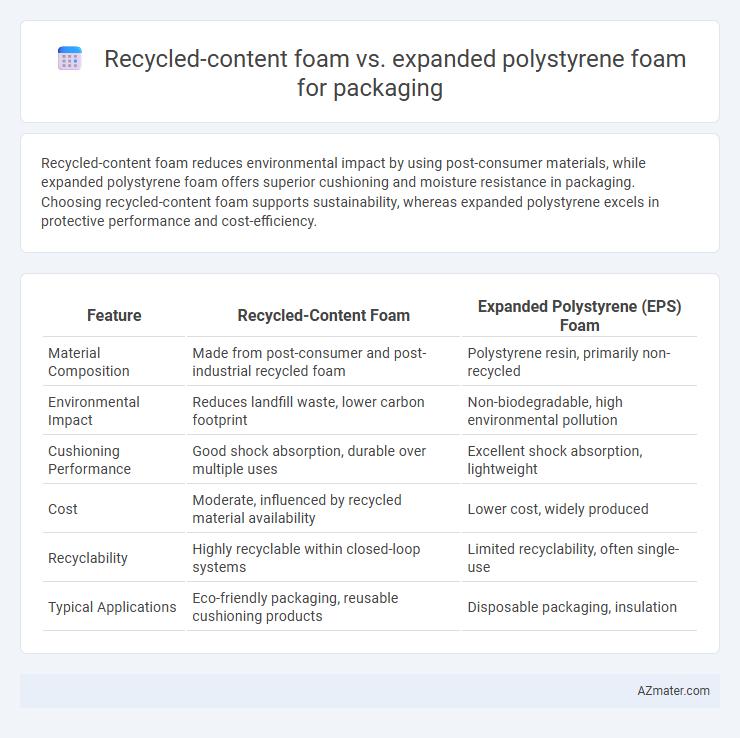Recycled-content foam reduces environmental impact by using post-consumer materials, while expanded polystyrene foam offers superior cushioning and moisture resistance in packaging. Choosing recycled-content foam supports sustainability, whereas expanded polystyrene excels in protective performance and cost-efficiency.
Table of Comparison
| Feature | Recycled-Content Foam | Expanded Polystyrene (EPS) Foam |
|---|---|---|
| Material Composition | Made from post-consumer and post-industrial recycled foam | Polystyrene resin, primarily non-recycled |
| Environmental Impact | Reduces landfill waste, lower carbon footprint | Non-biodegradable, high environmental pollution |
| Cushioning Performance | Good shock absorption, durable over multiple uses | Excellent shock absorption, lightweight |
| Cost | Moderate, influenced by recycled material availability | Lower cost, widely produced |
| Recyclability | Highly recyclable within closed-loop systems | Limited recyclability, often single-use |
| Typical Applications | Eco-friendly packaging, reusable cushioning products | Disposable packaging, insulation |
Introduction to Packaging Foams
Recycled-content foam offers an eco-friendly alternative to expanded polystyrene (EPS) foam, reducing environmental impact through the use of post-consumer materials while maintaining cushioning performance in packaging applications. EPS foam provides excellent protection and lightweight properties but poses challenges in biodegradability and recycling due to its petroleum-based composition. Selecting the appropriate packaging foam depends on balancing sustainability goals, mechanical protection requirements, and cost-effectiveness.
What Is Recycled-Content Foam?
Recycled-content foam is a sustainable packaging material made from post-consumer or post-industrial waste processed into new foam products, reducing landfill waste and conserving resources. Unlike expanded polystyrene (EPS) foam, which is primarily petroleum-based and non-biodegradable, recycled-content foam incorporates recycled polymers, enhancing environmental benefits without compromising cushioning and insulation properties. This foam type supports circular economy goals while maintaining protection for fragile items during shipping and handling.
Understanding Expanded Polystyrene (EPS) Foam
Expanded Polystyrene (EPS) foam is a lightweight, rigid cellular plastic used widely in packaging due to its excellent cushioning and insulating properties. Made from expanded beads of polystyrene resin, EPS offers high impact resistance and moisture resistance, making it ideal for protecting fragile items during shipping. Compared to recycled-content foam, EPS provides superior shock absorption but poses greater environmental challenges due to its low biodegradability and difficulties in recycling.
Environmental Impact: Recycled-Content vs EPS
Recycled-content foam significantly reduces landfill waste and lowers carbon emissions by reusing existing materials, compared to Expanded Polystyrene (EPS) foam, which is petroleum-based and slow to decompose. The production of recycled-content foam consumes less energy and generates fewer greenhouse gases, enhancing its sustainability profile. EPS foam's environmental impact is exacerbated by its non-biodegradable nature and the challenges associated with recycling or disposal.
Performance and Protection Capabilities
Recycled-content foam offers robust protection with improved environmental sustainability, maintaining comparable shock absorption and cushioning properties to Expanded Polystyrene (EPS) foam. EPS foam excels in lightweight performance and thermal insulation but is less eco-friendly due to its petroleum-based composition and limited recyclability. Both materials provide effective packaging protection, though recycled-content foam aligns better with green packaging initiatives without compromising durability.
Cost Comparison and Economic Considerations
Recycled-content foam typically offers a lower cost per unit compared to Expanded Polystyrene (EPS) foam, driven by the utilization of post-consumer materials and reduced manufacturing expenses. EPS foam, while often cheaper upfront, may incur higher environmental compliance and disposal costs, impacting its overall economic feasibility. When factoring long-term sustainability goals and potential regulatory incentives, recycled-content foam presents a more economically advantageous packaging solution.
Recyclability and End-of-Life Options
Recycled-content foam packaging offers improved environmental benefits with higher recyclability rates compared to expanded polystyrene (EPS), as it often incorporates post-consumer materials and supports closed-loop recycling systems. EPS foam, while lightweight and cushioning, presents significant challenges in end-of-life management due to its bulky volume and limited local recycling facilities, frequently resulting in landfill disposal. Choosing recycled-content foam enhances sustainability by reducing waste and promoting circular economy practices within packaging industries.
Regulatory and Industry Standards
Recycled-content foam for packaging increasingly meets stringent regulatory requirements such as EPA guidelines for recycled materials and ASTM standards for environmental safety, promoting sustainability in supply chains. Expanded polystyrene (EPS) foam is subject to regulations from entities like the FDA for food contact applications and ASTM D3841 for compressive properties, ensuring product safety and performance. Industry standards including ISO 14001 for environmental management indirectly influence both materials, driving improvements in manufacturing practices and end-of-life recyclability.
Popular Applications in Packaging
Recycled-content foam excels in sustainable packaging for electronics, food containers, and protective cushioning, offering eco-friendly alternatives that reduce landfill waste. Expanded polystyrene (EPS) foam is widely used for insulating food packaging, fragile product protection, and disposable containers due to its lightweight and shock-absorbing properties. Both materials serve crucial roles in packaging industries, balancing environmental impact and performance demands.
Choosing the Right Foam: Key Considerations
Recycled-content foam offers environmental advantages by reducing waste and conserving resources, making it a sustainable choice for packaging applications. Expanded polystyrene foam provides superior cushioning and lightweight protection, ideal for fragile or lightweight items during shipping. When choosing the right foam, consider factors such as product fragility, environmental impact, cost-effectiveness, and recyclability to ensure optimal protection and sustainability.

Infographic: Recycled-content foam vs Expanded polystyrene foam for Packaging
 azmater.com
azmater.com